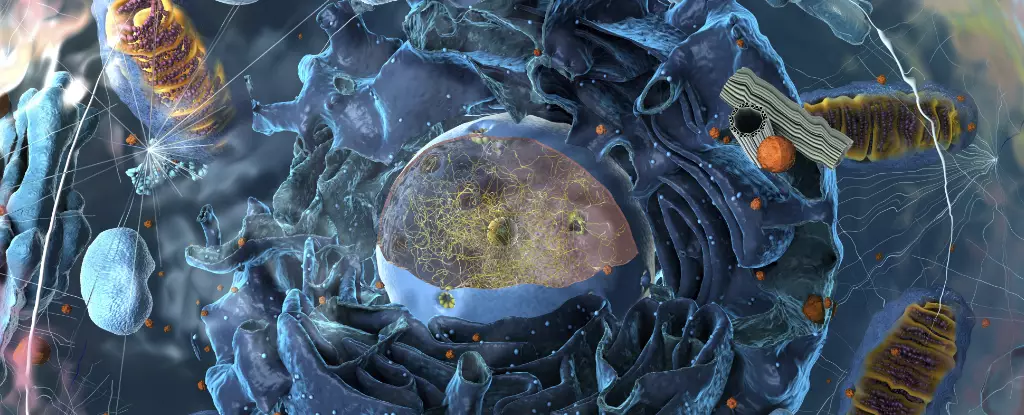The study of cell biology has typically been dominated by the structural concepts that characterize membrane-bound organelles. Traditionally, these organelles—such as mitochondria, lysosomes, and the nucleus—have held the spotlight due to their defined structures and recognized functions. However, a paradigm shift has unfolded in recent years, particularly since the mid-2000s, revealing the existence of biomolecular condensates, or membraneless organelles. These fluid-like structures have transformed our understanding of cellular organization, provoked questions about fundamental biological processes, and ignited discussions on the origins of life.
To envision what a biomolecular condensate looks like, it may help to imagine a lava lamp. In a lava lamp, wax blobs periodically coalesce, divide, and re-form, creating an ever-changing visual display. Similarly, biomolecular condensates are dynamic assemblies of proteins and RNA that emerge from the interactions between their constituents. Unlike traditional organelles, these condensates do not possess a surrounding membrane; rather, they exist as gel-like droplets that form when certain proteins and RNA preferentially bind to one another, rather than dispersing into the surrounding environment.
As of 2022, scientists have documented approximately 30 different types of these membraneless organelles, standing in stark contrast to the roughly twelve identified membrane-bound organelles. The variety and potential of biomolecular condensates raise intriguing questions about their specific functions within cells. While some biomolecular condensates, such as stress granules and ribosomes, play well-defined roles, many others remain enigmatic, reflecting a promising yet challenging frontier for biological research.
Identifying the exact roles of these biomolecular condensates presents a significant scientific hurdle. Some structures, like those involved in cellular stress responses or those implicated in RNA synthesis, are somewhat understood. However, many condensates are not linked to specific functions, thereby complicating our understanding of their biochemical significance. This ambiguity prompts scientists to revisit and revise established beliefs about cellular organization and functionality.
One of the key revelations brought about by the study of biomolecular condensates is the role of intrinsically disordered proteins (IDPs). Traditionally, the mantra “structure equals function” has guided biochemistry; proteins have specific 3D shapes that enable them to perform distinct tasks. However, IDPs—and the condensates they form—defy this rule. The initial confusion surrounding IDPs emphasized that lack of structure should mean a lack of function, but this assumption has been challenged by the discovery that these unstructured regions can lead to the formation of biomolecular condensates, ultimately suggesting intricate layers of functionality that were previously underappreciated.
Biomolecular Condensates in Prokaryotic Cells
The implications of biomolecular condensates extend beyond eukaryotic cells; their detection in prokaryotic organisms—historically classified as lacking organelles—has significant repercussions for our understanding of bacterial biology. With only about 6% of bacterial proteins exhibiting disordered regions, compared to 30-40% of non-bacterial proteins, the presence of condensates in bacteria suggests a level of complexity that challenges the notion of prokaryotes as simple cellular entities.
These findings highlight that bacterial cells engage in various complex processes, including RNA synthesis and degradation, through biomolecular condensates. The realization that prokaryotes can produce these dynamic structures underscores a re-evaluation of how we comprehend cellular life, suggesting that even the simplest organisms may possess capabilities we had previously overlooked.
The exploration of biomolecular condensates also dramatically reshapes discussions surrounding the origins of life on Earth. The RNA world hypothesis posits that early life forms were strands of RNA capable of self-replication. A pivotal aspect of this hypothesis has revolved around the necessity of membranes to house these RNA molecules. Given that the building blocks of membranes (lipids) may not have been abundantly available on early Earth, the capacity for RNA to aggregate into biomolecular condensates offers a compelling alternative. This suggests that life could have emerged from nonliving chemical processes without the need for membrane encapsulation.
Consequently, the ability of RNA to spontaneously form these condensates supports the idea that pathways leading from chemistry to biology were not only possible but perhaps inevitable.
As our understanding of biomolecular condensates advances, they are likely to influence more than just our theoretical insights into cell biology. Researchers are exploring their applications in the medical field, particularly concerning diseases like Alzheimer’s and Lou Gehrig’s disease. The potential to manipulate these structures offers exciting avenues for drug development and therapeutic strategies, though significant challenges remain.
Ultimately, as scientists delve deeper into the roles and functionalities of biomolecular condensates, it is likely that we will see a restructuring of many biological concepts. Over time, as each condensate is more thoroughly studied, students and educators alike may find that their biology lessons require significant updating. Thus, the implications of biomolecular condensates extend far beyond the laboratory benches and into the future of biological education and medical innovation.


Leave a Reply